
This Treasure is FAST: While internet searches may tell you that the Cheetah is the fastest animal on the planet, they are dead wrong. Today’s treasure can reach speeds faster than a moving Formula One race car. In fact, while in its spectacular dive, called a “stoop”, the Peregrine Falcon can reach speeds of up to 230 mph!
A Peregrine Falcon has two important needs … food, and a high place to live.
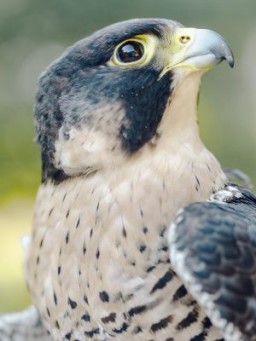 Body Designed for Hunting: Though no bigger than a crow, and weighing about 1½ lbs., a Peregrine (sometimes called a “Duck Hawk”) is the largest and most powerful species in the falcon family. It sports a blue-grey back, barred white underparts, a black head and a distinctive yellow circle around the eyes. Its pointed wings can span almost 4 feet and
Body Designed for Hunting: Though no bigger than a crow, and weighing about 1½ lbs., a Peregrine (sometimes called a “Duck Hawk”) is the largest and most powerful species in the falcon family. It sports a blue-grey back, barred white underparts, a black head and a distinctive yellow circle around the eyes. Its pointed wings can span almost 4 feet and
allows it to leisurely cruise at speeds up to 67 mph. If you are wondering why Peregrines need to cruise at such high speeds … the answer is that they eat highly mobile birds and sometimes bats.
Peregrine hunts get serious when prey is spotted during the cruising phase. At that point the high speed “stoop” begins from a great height. Due to their velocity, Peregrine Falcons aim not to catch their prey but to stun it with a blow before grabbing it as it falls. This maneuver is critical, as a hunting Peregrine is travelling so fast that a direct strike on prey could injure the Falcon itself.
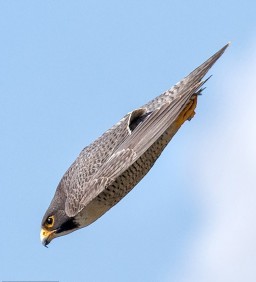 The bodies of Peregrine Falcons have many adaptations for hunting at high speeds. For starters, the shape of the Peregrine in a stoop has been compared by many to the shape of the B2 bomber. In addition, their nostrils guide shock waves of air to prevent the high pressure from damaging their lungs while they dive. This natural design actually influenced the design of the first jet engines!
The bodies of Peregrine Falcons have many adaptations for hunting at high speeds. For starters, the shape of the Peregrine in a stoop has been compared by many to the shape of the B2 bomber. In addition, their nostrils guide shock waves of air to prevent the high pressure from damaging their lungs while they dive. This natural design actually influenced the design of the first jet engines!
Peregrines also have excellent binocular vision, with resolution eight times better than that of humans, enabling them to see prey from more than a mile away. Like Owls, Peregrines have a third transparent eyelid. Its function is to spread tears and clear debris away, without obstructing vision during a high-speed stoop.
Four formidable yellow talons sport sharp, strongly curved toes. The Peregrine uses its large feet, with their powerful toes, to capture prey in the air or to knock it down. The final blow is then delivered when their unique notched beak bites through the neck of the prey to kill it. You can watch the whole hunt happening, in Rome … courtesy of David Attenborough.
Our many thanks to Thomas Kaestner for this wonderful photo of a Peregrine looking like a B2.
Digestion begins right after dinner and is a complex process involving storing food in a crop, then passing it through a two-part stomach; one section devoted to chemical breakdown of food (using acids and digestive juices) and one to mechanical breakdown of food (into smaller bits by grinding). The job of the intestinal tract is to absorb nutrients. Like owls, falcons regurgitate a pellet containing the undigestible body parts of what they have eaten. The pellet is not very recognizable because the falcon lacks the “garbage compactor” used by owls to produce a neat familiar package.
Home is a High Place: Because of the way Peregrines locate and hunt their prey, “hanging out” in high places makes a lot of sense. But they also nest in high places, such as cliffs up to 1300 feet high, choosing a ledge about a third of the way down the cliff face.
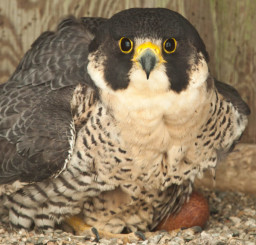 Family Life: Mated for life, Peregrines return to their nest in February, to perform incredible courtship displays during which the male executes acrobatic aerial feats designed to woo his mate. He starts by suppling the female with food, often dropping it for her to catch mid-flight …. sometimes while she is flying upside down! She needs more food than he does, as is the case with many birds. This is because the female has greater body mass than the male. Some theories speculate that this dimorphism occurs so that she can produce larger eggs and easily incubate them.
Family Life: Mated for life, Peregrines return to their nest in February, to perform incredible courtship displays during which the male executes acrobatic aerial feats designed to woo his mate. He starts by suppling the female with food, often dropping it for her to catch mid-flight …. sometimes while she is flying upside down! She needs more food than he does, as is the case with many birds. This is because the female has greater body mass than the male. Some theories speculate that this dimorphism occurs so that she can produce larger eggs and easily incubate them.
Courting, completed in March or April is followed by nest building. This activity is minimal, merely a ritualized scraping of the nest ledge to create a depression in the sand, gravel or other substrate of the nest site. “Scrape” is the name given to this rudimentary nest. No additional materials are used to house the 3-4 eggs she will lay and incubate for about 30 days; during this period the male will provide her with food. After hatching, young falcons will rely on their parents for food until they fledge, and become fully independent; this juvenile period lasts about 39 days.
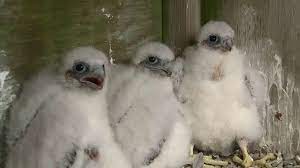
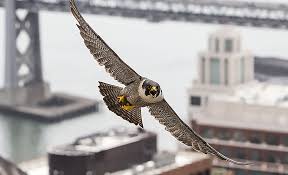 You Find Them Where? Remember the two things that Peregrines need, “food and a high place to live”? As it turns out this requirement can be met in some very unlikely settings. While cities are generally thought to be the complete antithesis of wildlife habitat, some species actually thrive in concrete jungles … and the Peregrine Falcon is one of them. They nest on window ledges of skyscrapers and feed on introduced species such as doves, pigeons, and ducks. Urban living thus meets the same needs as would the more natural setting of an ocean sea cliff!
You Find Them Where? Remember the two things that Peregrines need, “food and a high place to live”? As it turns out this requirement can be met in some very unlikely settings. While cities are generally thought to be the complete antithesis of wildlife habitat, some species actually thrive in concrete jungles … and the Peregrine Falcon is one of them. They nest on window ledges of skyscrapers and feed on introduced species such as doves, pigeons, and ducks. Urban living thus meets the same needs as would the more natural setting of an ocean sea cliff!
As a result, there are falcons in many surprising places. For example, they have been welcomed and cherished for more than 25 years at the second tallest building in Seattle. And the most famous city of skyscrapers, the “Big Apple” may now have the largest urban population of Peregrine Falcons anywhere. Not to be outdone by populations in New York City, Peregrines nest on every Hudson River bridge south of Albany, as well as on buildings and bridges in Syracuse, Rochester, Binghamton and Buffalo! These urban dwellers certainly live up to their name because both the English and scientific names of the species translates to “wandering falcon”. They also wander into More Mesa several times a year and have often been observed on the tall Eucalyptus trees near the coast. They are, if nothing else, extremely adaptable!
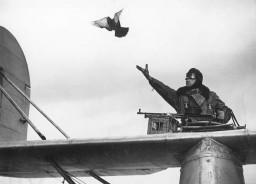 We Almost Lost Them Forever: Since the first half of the twentieth century, Peregrine Falcons have been exposed to dangerous threats that almost annihilated them. At first, they were heavily persecuted by gamekeepers and landowners, who were concerned about their stocks of game-birds. Then, during WW II, in a time before our digital world was even imagined, primitive methods of delivering messages were used. Specifically, thousands of Peregrines were also killed to protect the carrier pigeons carrying “important” military messages. After the war Peregrine numbers began to recover, and a full 10 years later, legislation finally outlawed their killing.
We Almost Lost Them Forever: Since the first half of the twentieth century, Peregrine Falcons have been exposed to dangerous threats that almost annihilated them. At first, they were heavily persecuted by gamekeepers and landowners, who were concerned about their stocks of game-birds. Then, during WW II, in a time before our digital world was even imagined, primitive methods of delivering messages were used. Specifically, thousands of Peregrines were also killed to protect the carrier pigeons carrying “important” military messages. After the war Peregrine numbers began to recover, and a full 10 years later, legislation finally outlawed their killing.
However, soon after this law was introduced, the numbers of many birds of prey, including Peregrines, began to plummet. Scientists eventually discovered the culprit to be agricultural pesticides … think DDT. This toxin, used to protect crops from insects, also poisoned birds, thinned their egg shells, killed developing embryos and pushed the Peregrine to the edge of extinction. (We had our own version of this nightmare with Bald Eagles on the Channel Islands.) DDT was eventually banned in 1972. This legislation, with additional large-scale protection of nesting places and releases into the wild, allowed the Peregrine to make a full recovery. Indeed, by 1999, President Clinton had the honor of announcing that, after being pushed nearly to the edge of extinction, Peregrines had been removed from the endangered species list. Today they are still listed as a “Bird of Special Concern”.
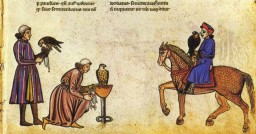 Falconry has Been Around a Long Time: The recovery of North American Peregrines was greatly aided by the activities of falconers dedicated to raptor conservation. With the sport originating somewhere between the Near and Middle East, there is ample evidence that falconry has been practiced for at least 3,500 years, (While various groups through the ages have used raptors to catch birds, falconers use only falcons for this purpose.) Falconry also became especially popular with European nobility during the Middle Ages. Little has changed fundamentally in the sport — or, as some would argue — the art of falconry since the practice first began. Today, falconry continues in the same fashion as it began thousands of years ago. (You might even remember the use of falcons in an effort to discourage Western Gulls from invading the Oakland Baseball Stadium.) Finally, although subjected to shifting popularity and restrictions, interest in falconry continues, and the intense relationship between falconers and their birds remains extremely and mysteriously strong.
Falconry has Been Around a Long Time: The recovery of North American Peregrines was greatly aided by the activities of falconers dedicated to raptor conservation. With the sport originating somewhere between the Near and Middle East, there is ample evidence that falconry has been practiced for at least 3,500 years, (While various groups through the ages have used raptors to catch birds, falconers use only falcons for this purpose.) Falconry also became especially popular with European nobility during the Middle Ages. Little has changed fundamentally in the sport — or, as some would argue — the art of falconry since the practice first began. Today, falconry continues in the same fashion as it began thousands of years ago. (You might even remember the use of falcons in an effort to discourage Western Gulls from invading the Oakland Baseball Stadium.) Finally, although subjected to shifting popularity and restrictions, interest in falconry continues, and the intense relationship between falconers and their birds remains extremely and mysteriously strong.
Stay safe … Valerie

 Annual Audubon Christmas Bird Count: Some of you may have seen a recent article in the Montecito Journal on the 121st Annual Audubon Christmas Bird Count. This yearly winter event is North America’s longest-running citizen science bird project, with the data collected fueling Audubon’s work throughout the entire year. Data from the count is also shared with the scientific community, universities, wildlife groups, government agencies and the public. Although this year’s data are still being validated, you can get a sense of the size of this undertaking, by knowing that last year there were 62,000 Americans who participated in the count. These reporters submitted over 2000 observations.
Annual Audubon Christmas Bird Count: Some of you may have seen a recent article in the Montecito Journal on the 121st Annual Audubon Christmas Bird Count. This yearly winter event is North America’s longest-running citizen science bird project, with the data collected fueling Audubon’s work throughout the entire year. Data from the count is also shared with the scientific community, universities, wildlife groups, government agencies and the public. Although this year’s data are still being validated, you can get a sense of the size of this undertaking, by knowing that last year there were 62,000 Americans who participated in the count. These reporters submitted over 2000 observations.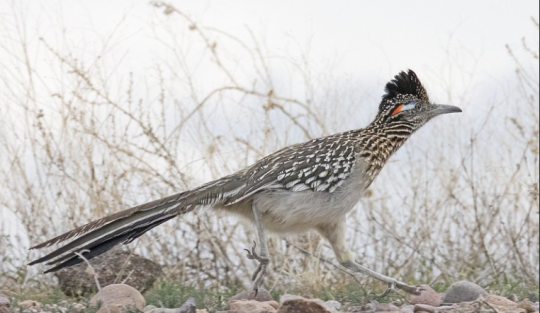
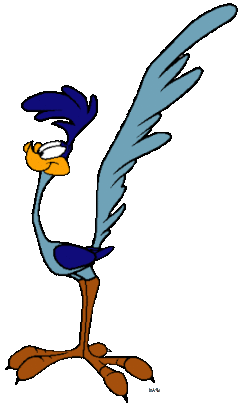 Rara Avis … a Rare Bird: This Treasure Hunt features a bird that has never been reported on More Mesa, until last Fall. It is the Greater Roadrunner; common in the Southwestern states of Texas, Oklahoma, New Mexico, and Arizona, but seen much less often in California. Roadrunner’s favorite habitats include deserts, brush and grasslands. Although somewhat rare, the Roadrunner is a species that most of us over age 50 met when we were kids; in the famous Roadrunner cartoons. This “Classic” cartoon series, introduced in 1949*, was written by Michael Maltese and animated by Chuck Jones. It ended in 1963 when Warner Brothers closed its Animation Studio.
Rara Avis … a Rare Bird: This Treasure Hunt features a bird that has never been reported on More Mesa, until last Fall. It is the Greater Roadrunner; common in the Southwestern states of Texas, Oklahoma, New Mexico, and Arizona, but seen much less often in California. Roadrunner’s favorite habitats include deserts, brush and grasslands. Although somewhat rare, the Roadrunner is a species that most of us over age 50 met when we were kids; in the famous Roadrunner cartoons. This “Classic” cartoon series, introduced in 1949*, was written by Michael Maltese and animated by Chuck Jones. It ended in 1963 when Warner Brothers closed its Animation Studio.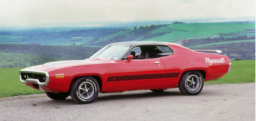 Sound: Roadrunners do not go Beep-Beep or Meep-Meep; these sounds were created by the animator of the cartoon. However, the Plymouth Roadrunner automobile, manufactured between 1968 and 1980, was not only named after the cartoon, but Plymouth also bought the rights to the horn and its well-known Beep-Beep. Among several other sounds, including lots of bill clacking, the (non-gasoline powered) Roadrunner actually goes co-coo-coo-coo-coooooo in a series of 3–8 downward slurring notes. These vocalizations are typical of a bird in the Cuckoo family and … no surprise … the Roadrunner is identified as a fast-running ground Cuckoo.
Sound: Roadrunners do not go Beep-Beep or Meep-Meep; these sounds were created by the animator of the cartoon. However, the Plymouth Roadrunner automobile, manufactured between 1968 and 1980, was not only named after the cartoon, but Plymouth also bought the rights to the horn and its well-known Beep-Beep. Among several other sounds, including lots of bill clacking, the (non-gasoline powered) Roadrunner actually goes co-coo-coo-coo-coooooo in a series of 3–8 downward slurring notes. These vocalizations are typical of a bird in the Cuckoo family and … no surprise … the Roadrunner is identified as a fast-running ground Cuckoo.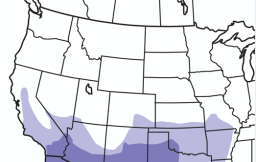 Population: Roadrunners were found in great numbers in Southwestern states like Arizona, New Mexico, Texas, Oklahoma and California until the 1940s. At that time their population declined sharply, not because Coyotes were catching and eating them, but because they were shot and killed under an umbrella of federal and state bounties. Today however, loss of habitat is a much bigger threat. Massive development, especially in California, pushes Roadrunners out of their homes, fragments their territories, drives away prey and eliminates nesting sites. Maps of Roadrunner locations list populations in many parts of California as “uncommon”. And a 1994 scholarly paper on Roadrunners declared them extirpated; locally extinct in Santa Barbara. Guess what? They’re back!
Population: Roadrunners were found in great numbers in Southwestern states like Arizona, New Mexico, Texas, Oklahoma and California until the 1940s. At that time their population declined sharply, not because Coyotes were catching and eating them, but because they were shot and killed under an umbrella of federal and state bounties. Today however, loss of habitat is a much bigger threat. Massive development, especially in California, pushes Roadrunners out of their homes, fragments their territories, drives away prey and eliminates nesting sites. Maps of Roadrunner locations list populations in many parts of California as “uncommon”. And a 1994 scholarly paper on Roadrunners declared them extirpated; locally extinct in Santa Barbara. Guess what? They’re back!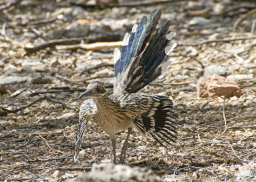 Interesting and Different: Actual roadrunners are far more interesting than their cartoon counterparts. The Roadrunner, unlike most birds, runs rather than flies, and feeds on some of the most unappetizing animals imaginable. These include scorpions, black widows and even venomous rattlesnakes. In fact, as omnivores, they will eat anything that is alive, weighs less than a pound, is moving and is not poisonous! It is also curiously unafraid of humans. Typically, a Roadrunner will trot up close, cock its head and peer at us, raise and lower its mop of shaggy crest and flip its long tail expressively. (The long tail feathers provide balance not only when it is looking at you, but when it is running as well.) These unusual traits point to it being completely unafraid and undeniably zany! (After all, the cartoon was part of the “Looney Tunes”family.)
Interesting and Different: Actual roadrunners are far more interesting than their cartoon counterparts. The Roadrunner, unlike most birds, runs rather than flies, and feeds on some of the most unappetizing animals imaginable. These include scorpions, black widows and even venomous rattlesnakes. In fact, as omnivores, they will eat anything that is alive, weighs less than a pound, is moving and is not poisonous! It is also curiously unafraid of humans. Typically, a Roadrunner will trot up close, cock its head and peer at us, raise and lower its mop of shaggy crest and flip its long tail expressively. (The long tail feathers provide balance not only when it is looking at you, but when it is running as well.) These unusual traits point to it being completely unafraid and undeniably zany! (After all, the cartoon was part of the “Looney Tunes”family.)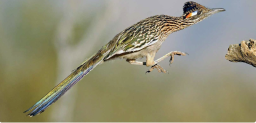 Not Much Reason to Fly: Because they can run fast and find almost all of their food on the ground, why bother to fly? Only if a Roadrunner has to escape a predator, reach a branch, or catch a flying insect, will it actually fly. The flight is then for very short distances, and only for a few seconds before it glides to a landing. This particular bird is simply not constructed for flying. The reason is that its skeleton cannot support a point of attachment for the large pectoral muscles required for prolonged and vigorous flight.
Not Much Reason to Fly: Because they can run fast and find almost all of their food on the ground, why bother to fly? Only if a Roadrunner has to escape a predator, reach a branch, or catch a flying insect, will it actually fly. The flight is then for very short distances, and only for a few seconds before it glides to a landing. This particular bird is simply not constructed for flying. The reason is that its skeleton cannot support a point of attachment for the large pectoral muscles required for prolonged and vigorous flight. Keeping Warm: On cool desert nights, Roadrunners enter a state of torpor by dropping their body temperatures; thereby conserving energy. To recover from their cold night of slumber, they spend the morning lying out in the sunlight, with their feathers raised to allow the sun to reach their black skin. If daytime temperatures drop in winter, they use the sun to warm up several times a day.
Keeping Warm: On cool desert nights, Roadrunners enter a state of torpor by dropping their body temperatures; thereby conserving energy. To recover from their cold night of slumber, they spend the morning lying out in the sunlight, with their feathers raised to allow the sun to reach their black skin. If daytime temperatures drop in winter, they use the sun to warm up several times a day.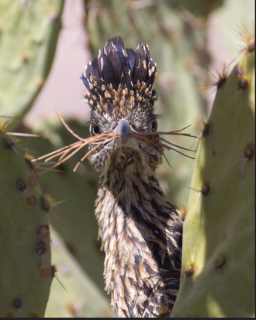 What About a Social Life? With all that chasing, “Roadrunner” did not have much chance for a social life. However, live Roadrunners are very serious about family matters. They defend their territory, have elaborate mating rituals, form life-long bonds and cooperatively work together in all aspects of reproduction. In order make the nest ready for eggs, each member of the pair has specific tasks. The male collects materials for the nest and the female builds it. She then lays 3-10 eggs. While both parents take turns incubating the eggs during the day, he gets all the night duty, because his body temperature does not drop after dark during nesting. Chicks hatch in 3 weeks and both parents will feed, protect and care for them for about a month. In favorable seasons (lots of food around) they can raise 3 broods of young in a single season.
What About a Social Life? With all that chasing, “Roadrunner” did not have much chance for a social life. However, live Roadrunners are very serious about family matters. They defend their territory, have elaborate mating rituals, form life-long bonds and cooperatively work together in all aspects of reproduction. In order make the nest ready for eggs, each member of the pair has specific tasks. The male collects materials for the nest and the female builds it. She then lays 3-10 eggs. While both parents take turns incubating the eggs during the day, he gets all the night duty, because his body temperature does not drop after dark during nesting. Chicks hatch in 3 weeks and both parents will feed, protect and care for them for about a month. In favorable seasons (lots of food around) they can raise 3 broods of young in a single season.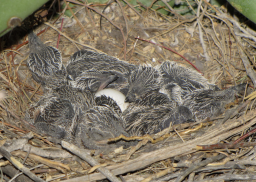
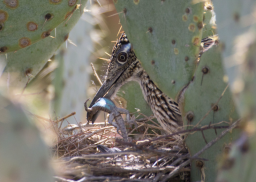

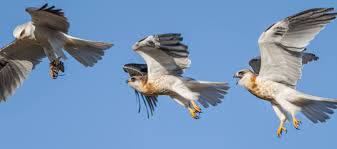 MMPC’s Signature Bird …
MMPC’s Signature Bird …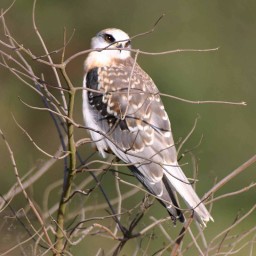 White-tailed Kite: The beautiful White-tailed Kite is the signature bird of MMPC and has been associated with us since we began our work more than 20 years ago. Because Kites are so very special, they are one of only 12 fully protected birds in the state of California. Our state’s classification of “Fully Protected” was, and remains, a way to identify and provide additional protection to those animals that are rare or face possible extinction. Further, with regard to the Federal Government, even though the White-tailed Kite is not listed as under the Endangered Species Act, it receives protection under the Federal Migratory Bird Treaty Act. Both of these are very serious protections!
White-tailed Kite: The beautiful White-tailed Kite is the signature bird of MMPC and has been associated with us since we began our work more than 20 years ago. Because Kites are so very special, they are one of only 12 fully protected birds in the state of California. Our state’s classification of “Fully Protected” was, and remains, a way to identify and provide additional protection to those animals that are rare or face possible extinction. Further, with regard to the Federal Government, even though the White-tailed Kite is not listed as under the Endangered Species Act, it receives protection under the Federal Migratory Bird Treaty Act. Both of these are very serious protections!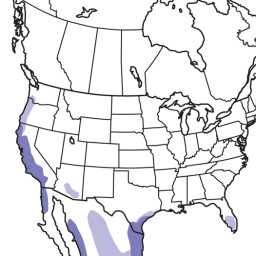 Where Are They: White-tailed Kites can be found on the West and Gulf Coasts of the United States and into Central and South America. Locally, they can be observed year-round along the California Coast, in open grassland, marshes and agricultural areas. Closer to home, our own More Mesa has played a vital role in the recovery of the species, not only on the South Coast, but for the whole state. It has accomplished this because it offers the critical hunting and nesting habitat necessary to support high densities of Kites. Therefore, as agricultural land in the Goleta Valley continues to shrink rapidly, preservation of More Mesa becomes an increasingly crucial part of safeguarding this beautiful bird.
Where Are They: White-tailed Kites can be found on the West and Gulf Coasts of the United States and into Central and South America. Locally, they can be observed year-round along the California Coast, in open grassland, marshes and agricultural areas. Closer to home, our own More Mesa has played a vital role in the recovery of the species, not only on the South Coast, but for the whole state. It has accomplished this because it offers the critical hunting and nesting habitat necessary to support high densities of Kites. Therefore, as agricultural land in the Goleta Valley continues to shrink rapidly, preservation of More Mesa becomes an increasingly crucial part of safeguarding this beautiful bird.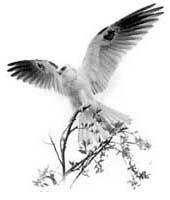 Beautiful and Easily Seen: The White-tailed Kite is a small hawk, easily identified by the all-white body and tail, and the black wing patches which are visible in flight or sitting. The open wings are sharply pointed with a three-foot span. Juveniles can be identified because their chest and head are lightly streaked with reddish/reddish orange color. And … all Kites have red eyes! But the dead-giveaway for a White-tailed Kite is their unusual hover flight when hunting. (More on this later.)
Beautiful and Easily Seen: The White-tailed Kite is a small hawk, easily identified by the all-white body and tail, and the black wing patches which are visible in flight or sitting. The open wings are sharply pointed with a three-foot span. Juveniles can be identified because their chest and head are lightly streaked with reddish/reddish orange color. And … all Kites have red eyes! But the dead-giveaway for a White-tailed Kite is their unusual hover flight when hunting. (More on this later.) Hunting Strategy: White-tailed Kites almost always hunt by hovering. (Watch this video to truly understand what is going on.) This distinctive hover behavior lasts up to a minute and ends with a successful prey strike only about 10% of the time.
Hunting Strategy: White-tailed Kites almost always hunt by hovering. (Watch this video to truly understand what is going on.) This distinctive hover behavior lasts up to a minute and ends with a successful prey strike only about 10% of the time.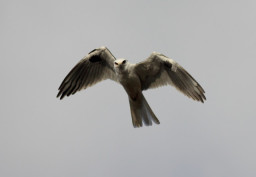 During “the hover”, the Kite is searching for prey, but in a very unusual fashion. As we have learned in past Treasure Hunts, avian vision is different for different species, and extremely well adapted in many remarkable and extraordinary ways. Their most incredible adaptation is their high resolution eyesight. However, the most unusual adaptation for avian vision, and raptors in particular, is the ability to see in the ultraviolet (UV). For those birds, who prey on rodents like voles and mice, this ability gives them a distinctive edge when hunting. This is because their prey, rodents, like many other species, use scent as a communication mechanism; marking territories, mating etc. Therefore, in these species, long scent trails become obvious markers of where the animal has been. An easier way to explain this is that rodents urinate by constantly “piddling”, leaving a trail behind them wherever they go. The usefulness of this habit to a hungry Kite takes a little explaining.
During “the hover”, the Kite is searching for prey, but in a very unusual fashion. As we have learned in past Treasure Hunts, avian vision is different for different species, and extremely well adapted in many remarkable and extraordinary ways. Their most incredible adaptation is their high resolution eyesight. However, the most unusual adaptation for avian vision, and raptors in particular, is the ability to see in the ultraviolet (UV). For those birds, who prey on rodents like voles and mice, this ability gives them a distinctive edge when hunting. This is because their prey, rodents, like many other species, use scent as a communication mechanism; marking territories, mating etc. Therefore, in these species, long scent trails become obvious markers of where the animal has been. An easier way to explain this is that rodents urinate by constantly “piddling”, leaving a trail behind them wherever they go. The usefulness of this habit to a hungry Kite takes a little explaining.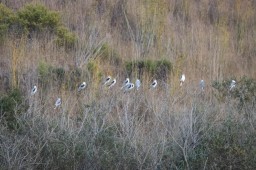 Meeting Up: White-tailed Kites often have winter get-togethers in what is known as a communal roost. The “roost” is when a group of individuals, typically of the same species, congregate in an area based on some external signal. In the case of Kites, that signal is nightfall. Once the roost is established, the birds return to the same place every evening around dusk. The benefits of this gathering could include better hunting, warmth, protection from predators and just plain “getting together with the gang”. (I learned a new phrase for this benefit; “conspecific interactions”.) While watching Kites in a recent large roost (see photo by Barry Rowan), I was also told by a well-known and recognized local birder, that he thought the juveniles were especially focused on the roost so they could select the best partners for the spring nesting season. (Does this remind you of going to the dance at the gym to pick out the best guy or gal to be with?)
Meeting Up: White-tailed Kites often have winter get-togethers in what is known as a communal roost. The “roost” is when a group of individuals, typically of the same species, congregate in an area based on some external signal. In the case of Kites, that signal is nightfall. Once the roost is established, the birds return to the same place every evening around dusk. The benefits of this gathering could include better hunting, warmth, protection from predators and just plain “getting together with the gang”. (I learned a new phrase for this benefit; “conspecific interactions”.) While watching Kites in a recent large roost (see photo by Barry Rowan), I was also told by a well-known and recognized local birder, that he thought the juveniles were especially focused on the roost so they could select the best partners for the spring nesting season. (Does this remind you of going to the dance at the gym to pick out the best guy or gal to be with?)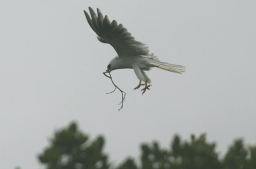 Keeping the Species From Disappearing … Chicks: More Mesa is considered the most important location for White-tailed Kite nesting on the South Coast. Because of the significance of this special bird, researchers have been studying and recording More Mesa’s Kites for nearly half a century. In pages 29-33 of our award winning More Mesa Handbook you can see that More Mesa consistently supports from one to three nesting sites with double-clutching (two families in one year) also observed in good rain years.
Keeping the Species From Disappearing … Chicks: More Mesa is considered the most important location for White-tailed Kite nesting on the South Coast. Because of the significance of this special bird, researchers have been studying and recording More Mesa’s Kites for nearly half a century. In pages 29-33 of our award winning More Mesa Handbook you can see that More Mesa consistently supports from one to three nesting sites with double-clutching (two families in one year) also observed in good rain years.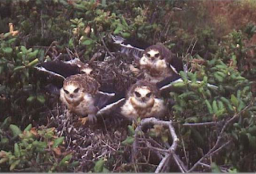 December is courting season for White-tailed Kites. (Perhaps the males are seeking out that one female who caught their eye at the roost?) Courtship can often be in the form of ritualized displays. In one of these, a male offers prey to a female and then, in a spectacular aerial exchange, the female flies up to meet the male, turns upside-down, and grasps the prey. After they are both suitably impressed with one another, the two will form a monogamous pair in December, and stay together year-round. Nest building starts in January with White-tailed Kites typically choosing nurseries in the upper third of trees that may be 10–160 feet tall. The nest, which is made of twigs and lined with grass, weeds, or leaves can be built by the female or the pair. Its construction takes 1-4 weeks. When complete, the female usually lays 4 eggs and incubates them for about a month. During that time, the male brings food to the her and continues to do so until the eggs hatch. However, once the chicks have hatched, dad has to find food for both mom and the growing chicks! Mom is then responsible for transferring the food he delivers to the chicks in the nest. Even after the chicks have learned to fly, they are expecting free meals from dad. And, like most teenagers, they are pretty demanding! You can see that in the behavior in the photo below … where two chicks are competing over food that dad has procured. It is also evident in the header photo where the juveniles are chasing an adult with food. After those two-three exhausting months for mom and dad, the kids are on their own. It’s truly amazing that pairs still possess the energy to raise two broods in a season … even with plenty of food around!
December is courting season for White-tailed Kites. (Perhaps the males are seeking out that one female who caught their eye at the roost?) Courtship can often be in the form of ritualized displays. In one of these, a male offers prey to a female and then, in a spectacular aerial exchange, the female flies up to meet the male, turns upside-down, and grasps the prey. After they are both suitably impressed with one another, the two will form a monogamous pair in December, and stay together year-round. Nest building starts in January with White-tailed Kites typically choosing nurseries in the upper third of trees that may be 10–160 feet tall. The nest, which is made of twigs and lined with grass, weeds, or leaves can be built by the female or the pair. Its construction takes 1-4 weeks. When complete, the female usually lays 4 eggs and incubates them for about a month. During that time, the male brings food to the her and continues to do so until the eggs hatch. However, once the chicks have hatched, dad has to find food for both mom and the growing chicks! Mom is then responsible for transferring the food he delivers to the chicks in the nest. Even after the chicks have learned to fly, they are expecting free meals from dad. And, like most teenagers, they are pretty demanding! You can see that in the behavior in the photo below … where two chicks are competing over food that dad has procured. It is also evident in the header photo where the juveniles are chasing an adult with food. After those two-three exhausting months for mom and dad, the kids are on their own. It’s truly amazing that pairs still possess the energy to raise two broods in a season … even with plenty of food around!
 Which Came First?: Ask any group of random folks what a kite is and they will say it’s the paper thing attached to a string that people fly on windy days in Mary Poppins. And it is. Ask the same group why our emblematic bird is called a Kite and they would probably say “because it looks like a “kite”. But it is believed that the bird actually came before the paper thing. Apparently, the word “kite” was derived from the Old English word “cyta” meaning to shoot up or go swiftly. Therefore, the word seemed like a good fit for a bird that could swoop on prey, hover in flight and soar. More than 20 Kite species are found all over the world so millions of people are able to marvel at their airborne ballets. As for the other “kite”, it is believed that the paper thing was originally constructed in China. Its form resembles the bird because the paper kite hovers nearly motionless in the air … similar to Kite behavior. However, it can never match the antics of a living Kite.
Which Came First?: Ask any group of random folks what a kite is and they will say it’s the paper thing attached to a string that people fly on windy days in Mary Poppins. And it is. Ask the same group why our emblematic bird is called a Kite and they would probably say “because it looks like a “kite”. But it is believed that the bird actually came before the paper thing. Apparently, the word “kite” was derived from the Old English word “cyta” meaning to shoot up or go swiftly. Therefore, the word seemed like a good fit for a bird that could swoop on prey, hover in flight and soar. More than 20 Kite species are found all over the world so millions of people are able to marvel at their airborne ballets. As for the other “kite”, it is believed that the paper thing was originally constructed in China. Its form resembles the bird because the paper kite hovers nearly motionless in the air … similar to Kite behavior. However, it can never match the antics of a living Kite.
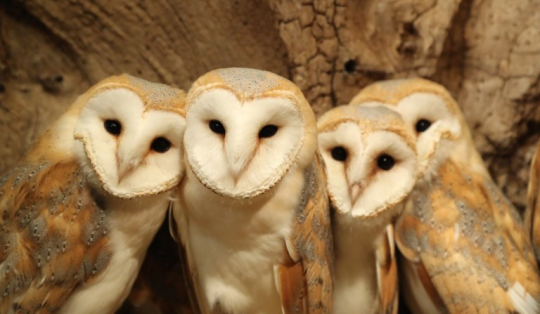
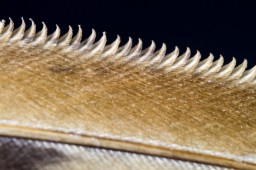


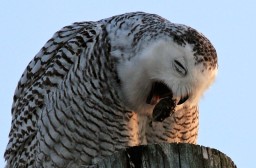
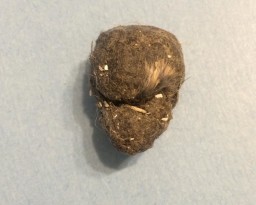
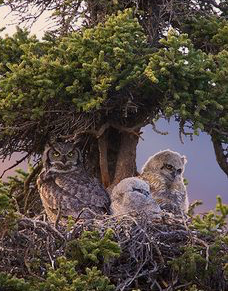

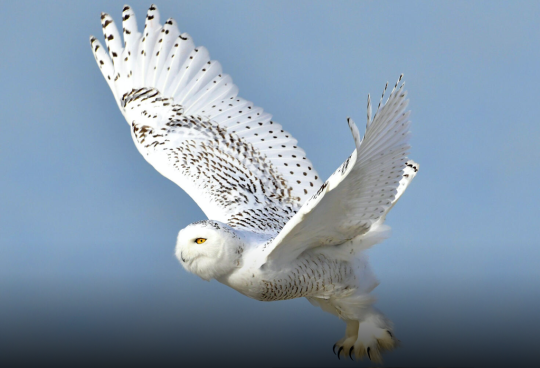

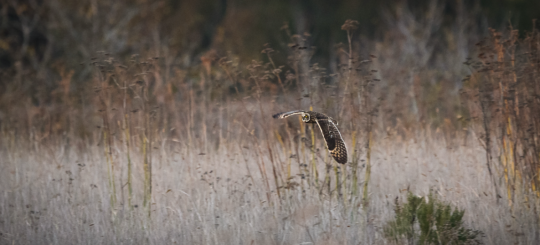 WHOOOOO? … IT’S OWLS
WHOOOOO? … IT’S OWLS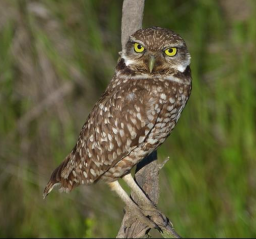
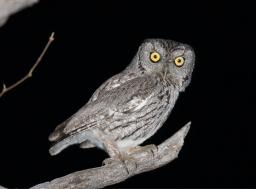
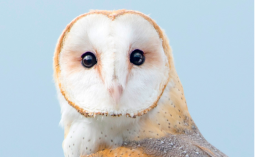

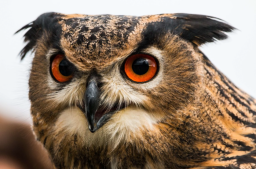
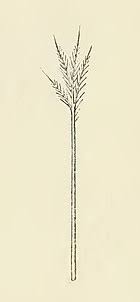
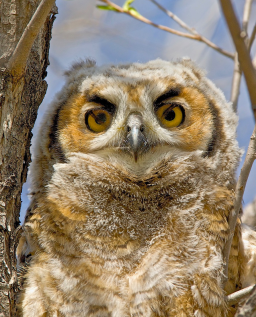
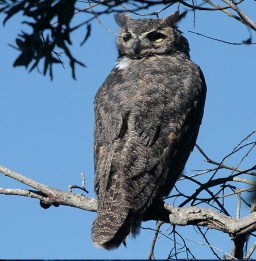
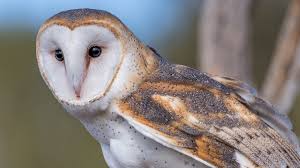
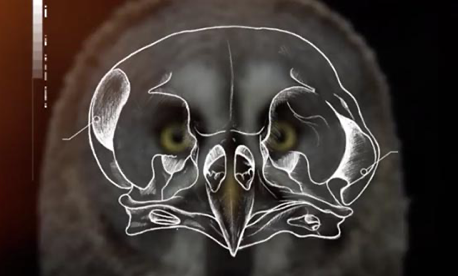 such that owls can detect a left/right time difference of about 30 millionths of a second! To see owl hearing in action, check out
such that owls can detect a left/right time difference of about 30 millionths of a second! To see owl hearing in action, check out